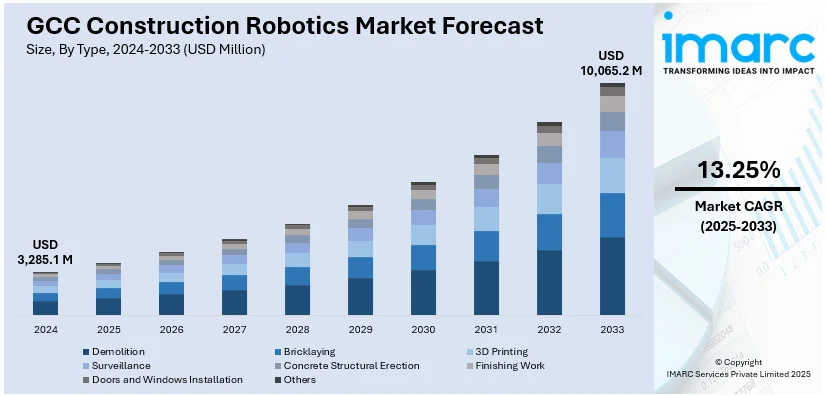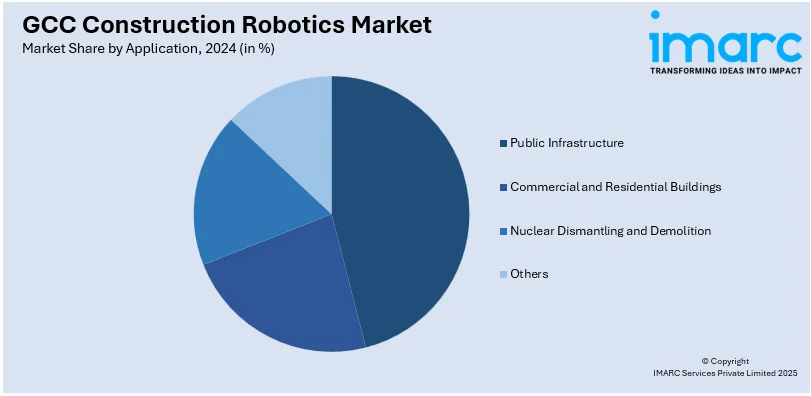
GCC Construction Robotics Market Report by Type (Demolition, Bricklaying, 3D Printing, Surveillance, Concrete Structural Erection, Finishing Work, Doors and Windows Installation, and Others), Application (Public Infrastructure, Commercial and Residential Buildings, Nuclear Dismantling and Demolition, and Others), End User (Residential, Industrial, Commercial), and Country 2025-2033
Market Overview:
GCC construction robotics market size reached USD 3,285.1 Million in 2024. Looking forward, IMARC Group expects the market to reach USD 10,065.2 Million by 2033, exhibiting a growth rate (CAGR) of 13.25% during 2025-2033. The ongoing advancements in robotics technology, artificial intelligence, and sensor capabilities, which continue to enhance the capabilities of construction robots, are driving the market.
|
Report Attribute
|
Key Statistics
|
|---|---|
|
Base Year
|
2024
|
|
Forecast Years
|
2025-2033
|
|
Historical Years
|
2019-2024
|
| Market Size in 2024 | USD 3,285.1 Million |
| Market Forecast in 2033 | USD 10,065.2 Million |
| Market Growth Rate 2025-2033 | 13.25% |
Construction robotics involves the integration of robotic technology into various aspects of the construction industry, revolutionizing traditional building methods. These robots are designed to perform tasks such as bricklaying, concrete pouring, welding, and even demolition, enhancing efficiency, accuracy, and safety on construction sites. Equipped with advanced sensors, artificial intelligence, and automation capabilities, construction robots can operate in diverse environments, adapting to complex structures and reducing the need for human labor in hazardous or repetitive tasks. This technology aims to streamline construction processes, minimize errors, and accelerate project timelines. As construction robotics continues to evolve, it holds the potential to address labor shortages, improve construction quality, and contribute to sustainable building practices.

To get more information on this market, Request Sample
GCC Construction Robotics Market Trends:
The construction robotics market in GCC is experiencing robust growth, primarily propelled by several key drivers. Firstly, the increasing demand for cost-effective and efficient construction processes has fueled the adoption of robotics in the industry. Additionally, the regional shortage of skilled labor has created a pressing need for automation solutions, driving the integration of robotics into construction workflows. Furthermore, stringent safety regulations and a growing emphasis on workplace safety have prompted construction companies to invest in robotic technologies that can mitigate risks and enhance overall project safety. Moreover, the rising complexity of construction projects, coupled with the need for precision and speed, has made robotics an indispensable tool for modern construction companies. Furthermore, advancements in artificial intelligence and machine learning have enabled the development of sophisticated robotic systems capable of performing complex tasks with a high degree of accuracy. The integration of IoT (Internet of Things) technology has also played a pivotal role in the expansion of the construction robotics market, providing real-time data and connectivity for enhanced project management and monitoring. In conclusion, the construction robotics market in GCC is being propelled by a confluence of factors, including the need for efficiency, labor shortages, safety concerns, technological advancements, and the growing complexity of construction projects.
GCC Construction Robotics Market Segmentation:
IMARC Group provides an analysis of the key trends in each segment of the market, along with forecasts at the regional and country levels for 2025-2033. Our report has categorized the market based on type, application, and end user.
Type Insights:
- Demolition
- Bricklaying
- 3D Printing
- Surveillance
- Concrete Structural Erection
- Finishing Work
- Doors and Windows Installation
- Others
The report has provided a detailed breakup and analysis of the market based on the type. This includes demolition, bricklaying, 3D printing, surveillance, concrete structural erection, finishing work, doors and windows installation, and others.
Application Insights:

- Public Infrastructure
- Commercial and Residential Buildings
- Nuclear Dismantling and Demolition
- Others
A detailed breakup and analysis of the market based on the application have also been provided in the report. This includes public infrastructure, commercial and residential buildings, nuclear dismantling and demolition, and others.
End User Insights:
- Residential
- Industrial
- Commercial
The report has provided a detailed breakup and analysis of the market based on the end user. This includes residential, industrial, and commercial.
Country Insights:
- Saudi Arabia
- United Arab Emirates
- Qatar
- Kuwait
- Oman
- Bahrain
The report has also provided a comprehensive analysis of all the major regional markets, which include Saudi Arabia, United Arab Emirates, Qatar, Kuwait, Oman, and Bahrain.
Competitive Landscape:
The market research report has also provided a comprehensive analysis of the competitive landscape in the market. Competitive analysis such as market structure, key player positioning, top winning strategies, competitive dashboard, and company evaluation quadrant has been covered in the report. Also, detailed profiles of all major companies have been provided.
GCC Construction Robotics Market Report Coverage:
| Report Features | Details |
|---|---|
| Base Year of the Analysis | 2024 |
| Historical Period | 2019-2024 |
| Forecast Period | 2025-2033 |
| Units | Million USD |
| Scope of the Report | Exploration of Historical Trends and Market Outlook, Industry Catalysts and Challenges, Segment-Wise Historical and Future Market Assessment:
|
| Types Covered | Demolition, Bricklaying, 3D Printing, Surveillance, Concrete Structural Erection, Finishing Work, Doors and Windows Installation, Others |
| Applications Covered | Public Infrastructure, Commercial and Residential Buildings, Nuclear Dismantling and Demolition, Others |
| End Users Covered | Residential, Industrial, Commercial |
| Countries Covered | Saudi Arabia, United Arab Emirates, Qatar, Kuwait, Oman, Bahrain |
| Customization Scope | 10% Free Customization |
| Post-Sale Analyst Support | 10-12 Weeks |
| Delivery Format | PDF and Excel through Email (We can also provide the editable version of the report in PPT/Word format on special request) |
Key Questions Answered in This Report:
- How has the GCC construction robotics market performed so far and how will it perform in the coming years?
- What has been the impact of COVID-19 on the GCC construction robotics market?
- What is the breakup of the GCC construction robotics market on the basis of type?
- What is the breakup of the GCC construction robotics market on the basis of application?
- What is the breakup of the GCC construction robotics market on the basis of end user?
- What are the various stages in the value chain of the GCC construction robotics market?
- What are the key driving factors and challenges in the GCC construction robotics?
- What is the structure of the GCC construction robotics market and who are the key players?
- What is the degree of competition in the GCC construction robotics market?
Key Benefits for Stakeholders:
- IMARC’s industry report offers a comprehensive quantitative analysis of various market segments, historical and current market trends, market forecasts, and dynamics of the GCC construction robotics market from 2019-2033.
- The research report provides the latest information on the market drivers, challenges, and opportunities in the GCC construction robotics market.
- Porter's five forces analysis assist stakeholders in assessing the impact of new entrants, competitive rivalry, supplier power, buyer power, and the threat of substitution. It helps stakeholders to analyze the level of competition within the GCC construction robotics industry and its attractiveness.
- Competitive landscape allows stakeholders to understand their competitive environment and provides an insight into the current positions of key players in the market.
Need more help?
- Speak to our experienced analysts for insights on the current market scenarios.
- Include additional segments and countries to customize the report as per your requirement.
- Gain an unparalleled competitive advantage in your domain by understanding how to utilize the report and positively impacting your operations and revenue.
- For further assistance, please connect with our analysts.
 Request Customization
Request Customization
 Speak to an Analyst
Speak to an Analyst
 Request Brochure
Request Brochure
 Inquire Before Buying
Inquire Before Buying




.webp)




.webp)












